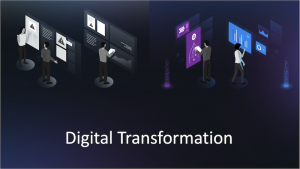Organizations in every industry are engaged in some form of digital transformation, integrating technology into all areas of the business. Digital transformation strategies are fundamentally changing how organizations operate and deliver value to customers. Some of the benefits organizations seek from digital transformation journeys include the following:
- Increased DevOps automation and efficiency. Digital tools and technologies provide a more efficient way of doing things. They help organizations streamline and automate complex and time-consuming procedures and improve overall performance.
- Improved customer experience. Consumers expect personalized, proactive, and convenient service, which traditional application architectures often struggle to provide.
- Competitive advantage. A comprehensive digital transformation strategy can help organizations better understand the market, reach customers more effectively, and respond to changing demand more quickly.
- Enhanced business operations. Digitizing internal processes can improve information flow and enhance collaboration among employees. With teams all using the same data, it’s easier for the organization to make data-driven decisions.
However, digital transformation requires significant investment in technology infrastructure and processes. It often involves replacing legacy systems and workflows that have been in place for years or even decades. Because it’s an ongoing process, digital transformation requires that teams continually adapt and evolve as new technologies emerge and customer expectations change. As a result, a successful digital transformation strategy requires that organizations make changes to organizational culture and provide employee training.
In a panel discussion at Perform 2023, Debbie Umbach, vice president of corporate marketing at Dynatrace, explored the successful digital transformation strategies of three Dynatrace customers: Best Buy, a multinational consumer electronics retailer; a top global retail and corporate finance service provider in the banking industry; and the Department of Veterans Affairs (VA), the second largest U.S. federal agency.
Digital transformation challenges: Goals for a successful digital transformation journey
Every organization faces unique challenges. Finding the solutions to these challenges becomes the goals for each panelist’s successful digital transformation strategy.
The global banking leader is seeking better ways to detect and manage alerts from multiple sources, improve platform resilience, and to better understand the business cost of a technical failure.
The goals of VA are to streamline operations and become more proactive so they can head off problems before their users find them, thus creating delightful user experiences for their diverse community.
Best Buy is designing its journey to cut through the noise of its multicloud and multi-tool environments to immediately pinpoint the root causes of issues during peak traffic loads.
Digital transformation security risks
Increasingly, observability of DevOps workflows is converging with application security. The proof point for one organization is Log4Shell, a critical zero-day vulnerability discovered in a popular Java library in 2021.
With Dynatrace Application Security, VA was able to immediately detect whether the vulnerability was present in any of its systems. Additionally, contextualized real-time dependency mapping and automatic analysis enabled them to quickly assess the risk and take action to protect user data and critical infrastructure.
Digital transformation success stories: Operational benefits
In addition to immediate threat response, VA teams were also able to unlock more automation and reduce mean time to repair (MTTR) so they could resolve issues before they affected users or compromised systems.
Best Buy is automating service level objectives (SLOs) for milestones such as staging gates and version control, which enables them to streamline DevOps workflows and cut red tape.
An additional game changer for Best Buy is Dynatrace anomaly detection and tool consolidation. Previously, they had 12 tools with different traffic thresholds. With Dynatrace, they now have a single unified platform that measures all the thresholds looking for differences, which makes it easy to find a performance spike in a torrent of data from different sources.
Advice for a successful digital transformation strategy
In the process of their digital transformation journeys, the panelists learned some lessons they wanted to pass on. After getting the right observability and analytics platform in place, the primary key to success is enabling teams to access it en masse. Their advice includes the following practices:
- Get technical and platform teams on board. With the key players advocating organizational change, teams can adopt new technologies and methods faster.
- Enable teams with ongoing education so they get the most out of Dynatrace capabilities. This keeps teams from falling into old habits and enables them to continually innovate and expand.
- Turn off the tools you no longer need. Although teams can often get attached to old tools and methods, it’s easier, in the long run, to stop using them.
- Take advantage of Dynatrace University. The 3–5-minute videos make it easy for teams to quickly learn how to do things at their own pace as they’re solving problems.
- Don’t let perfect get in the way of good. Whether it’s cloud migration or monitoring, don’t be afraid to try something. It’s better to get some traction and fail fast, then recover and continue to build.
Watch the full session to learn more about how these organizations use Dynatrace to execute their digital transformation strategies. Customer panel: Successful digital transformation journeys






Looking for answers?
Start a new discussion or ask for help in our Q&A forum.
Go to forum